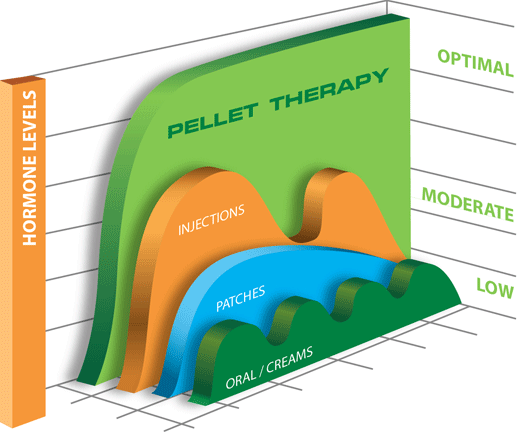Hormone Pellets
in Boca Raton, FL
The History of Pellet Hormone Replacement Therapy
Both men and women have been using pellet therapy since the late 1930’s. Pellets were commonly used in the United States from about 1940 through the early 80’s. There is more data that supports the use of pellets than any other hormone delivery method. Most of the research available on pellets come from England and Australia.
70+ years of research has illustrated the benefits of bioidentical hormone pellet implants in both women and men. Pellet implants deliver consistent, physiologic levels of hormones. Pellet dosing is individualized and calculated for each person for optimal results. Pellet implants bypass the liver and don’t negatively impact clotting factors, blood pressure, lipid levels, glucose, or liver function.
What is Pellet Hormone Replacement Therapy?
For Both Men and Women Pellet Hormone Therapy Addresses:
- Mood Swings
- Diminishing Vitality
- Anxiety
- Sleeplessness
- Brain Fog
- Low Libido & Energy
- Thinning Hair
- Weight Issues
Pellets are far superior to bioidentical (BHRT) or Pharmaceutical hormone pills, patches and creams which deliver dosages that cannot align with your body’s daily needs. With hormone pellets you will always be in balance and feeling great because pellets are always available to deliver a perfect dose of what the body needs, every day.
Think of it like a reservoir. The hormones, which are about the size of rice and placed subcutaneously, are always available and when your body needs them it can go to the reservoir and fill up like one would fill a glass of water when thirsty. When the body is in balance there is no unnecessary dose as there would be with creams and pills which are taken in the same amount daily, regardless of your body’s actual hormone levels and needs. When you are stressed or generating the need for more hormones (as also happens with exercise) your hormone pellets are available for the body to access and find balance.
And with pellets you’ll begin to feel the positive physical and emotional effects of being in hormonal balance within two days.
Bioidentical hormone pellets have been used with great success in the U.S., Europe, and Australia since 1938. In fact, pellet implants were a very popular mode of hormone administration in the U.S. until the 1970s, when many synthetic oral and topical commercial products were developed by pharmaceutical companies. While the demand for pellets diminished in the U.S., pellet implants continued to be a very popular mode of hormone administration throughout Europe and Australia. In the last 10 years, due to advances made in processes and a better understanding of the benefits of pellet implants for hormone replacement, this mode of hormone therapy has grown in popularity in the U.S.

The Benefits of Pellet Hormone Replacement Therapy
- Pellet Hormone Therapy simplifies and optimizes hormone regulation: Unlike with pills, tablets or patches, pellet therapy leaves no room for user error. You can get pelleted and forget any additional worry. Bioidentical hormone pellet therapy is the most convenient of all the other methods because it does not require the addition of a new daily routine.
- A more natural therapy than pharmaceuticals: The hormones used in pellet therapy are derived from natural plant sources and are chemically identical to the hormones your body produces naturally.
- Greater Efficacy: Pelleting provides results for helping both men and women with age-related issues such as energy, mood, sleep cycle, vitality, strength and virility.
- Long lasting and less work and worry: A single pellet injection lasts for months, compared to the short duration of other delivery methods. With pellet therapy, natural hormones are present 24 hours a day, providing constant balance and benefits.
- Consistency: Unlike the “roller coaster” effect from other hormone delivery methods, the pellet therapy process gives you consistent hormone levels throughout the day that raise and lower themselves naturally.
Am I a candidate for Pellet Hormone Replacement Therapy?
Symptoms such as depression, low libido, brain fog, sleeplessness, muscle loss and low energy. Furthermore, conditions of aging like menopause and perimenopause in women can cause hot flashes, mood swings, and weight gain while even post-menopausal women experience symptoms including but not limited to hair loss, acne and low libido and irregular menstrual cycles.
Aging has an effect on men known as andropause, which is caused by fluctuation of testosterone levels and causes many of the same symptoms. Testosterone replacement can restore your vitality, sex drive and have profound effects on your ability to retain muscle mass, cognition and energy levels.
Testosterone levels in men begin to decline in their 30’s. When they begin to show signs of testosterone deficiency men should get tested. Men in their 30’s can be testosterone deficient and show signs of bone loss, and most men need to be tested by around 50 years of age.
The first step in determining if your symptoms are the result of a hormonal imbalance and that you are a candidate for bio-identical pellet hormone replacement therapy is comprehensive lab testing.
Lab testing measures the current status of your natural hormones and your overall health and wellbeing. Our physicians will use the results of this lab testing along with your medical history and current symptoms to develop a treatment plan and determine if hormone replacement therapy is right for you.


